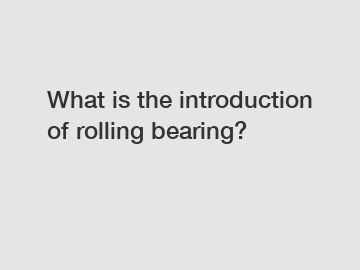What is the introduction of rolling bearing?
1. History of Rolling Bearings:
2. Structure and Function:
Rolling bearings consist of four fundamental components – an inner ring, outer ring, rolling elements, and a cage. The inner and outer rings contain raceways that guide the rolling elements, enabling smooth rotational movement. The rolling elements, usually balls or rollers, reduce friction between the rings and distribute the load evenly. Meanwhile, the cage ensures proper spacing and alignment of the rolling elements.

3. Types of Rolling Bearings:
There are various types of rolling bearings tailored for specific applications. Some common examples include ball bearings, roller bearings, needle bearings, and tapered roller bearings. Ball bearings are widely used due to their versatility and high load-carrying capacity. Roller bearings, on the other hand, are better suited for heavy-load applications. Needle bearings are compact and suitable for applications with limited space, while tapered roller bearings handle axial and radial loads.
4. Advantages of Rolling Bearings:
Rolling bearings offer several advantages that make them indispensable in modern machinery. Firstly, they significantly reduce friction, thus increasing efficiency and extending the lifespan of moving parts. Secondly, they provide excellent load-carrying capabilities, ensuring smooth operation even under heavy loads. Additionally, rolling bearings require minimal lubrication and are easily replaceable, making maintenance procedures relatively straightforward.
5. Applications:
Rolling bearings find applications in a vast array of industries, ranging from automotive and aerospace to manufacturing and energy production. In the automotive sector, they are found in engines, transmissions, and steering systems. In the aerospace industry, they contribute to the functioning of various aircraft components. Additionally, rolling bearings enable smooth operation in machinery used in power plants, wind turbines, and even robotics.
6. Specialty and High-Temperature Bearings:
Certain applications require rolling bearings that can withstand extreme conditions. Specialty bearings, such as ceramic bearings, are designed to operate at high temperatures and offer superior corrosion resistance. These specialized bearings are used in industries like steel manufacturing, where extreme heat and harsh environments are common.
7. Recent Technological Advancements:
Technological advancements continue to shape the world of rolling bearings. Today, manufacturers focus on producing bearings that are smaller, lighter, and more efficient, while maintaining durability. Innovations like smart bearings with built-in sensors capable of detecting deviations in performance or potential failures have opened new avenues for predictive maintenance and increased machine reliability.
Contact us to discuss your requirements of Top Ball Bearing Manufacturers, China Ball Bearings, Chinese High Quality Bearing. Our experienced sales team can help you identify the options that best suit your needs.

Comments